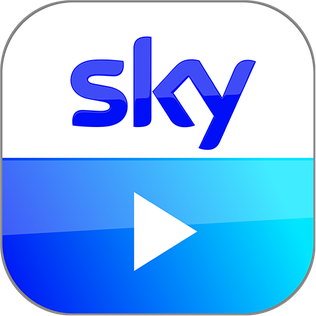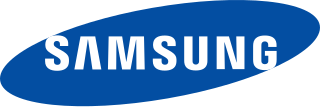Related Research Articles

BlackBerry is a discontinued brand of smartphones and other related mobile services and devices. The line was originally developed and maintained by the Canadian company BlackBerry Limited from 1999 to 2016, after which it was licensed to various companies.

A smartphone, often simply called a phone, is a mobile device that combines the functionality of a traditional mobile phone with advanced computing capabilities. It typically has a touchscreen interface, allowing users to access a wide range of applications and services, such as web browsing, email, and social media, as well as multimedia playback and streaming. Smartphones have built-in cameras, GPS navigation, and support for various communication methods, including voice calls, text messaging, and internet-based messaging apps.
DigitalLiving Network Alliance (DLNA) is a set of interoperability standards for sharing home digital media among multimedia devices. It allows users to share or stream stored media files to various certified devices on the same network like PCs, smartphones, TV sets, game consoles, stereo systems, and NASs. DLNA incorporates several existing public standards, including Universal Plug and Play (UPnP) for media management and device discovery and control, wired and wireless networking standards, and widely used digital media formats. Many routers and network attached storage (NAS) devices have built-in DLNA support, as well as software applications like Windows Media Player.
Qualcomm Atheros is a developer of semiconductor chips for network communications, particularly wireless chipsets. The company was founded under the name T-Span Systems in 1998 by experts in signal processing and VLSI design from Stanford University, the University of California, Berkeley, and private industry. The company was renamed Atheros Communications in 2000 and it completed an initial public offering in February 2004, trading on the NASDAQ under the symbol ATHR.

A digital media player is a type of consumer electronics device designed for the storage, playback, or viewing of digital media content. They are typically designed to be integrated into a home cinema configuration, and attached to a television or AV receiver or both.
Monsoon Multimedia was a company that manufactured, developed and sold video streaming and place-shifting devices that allowed consumers to view and control live television on PCs connected to a local (home) network or remotely from a broadband-connected PC or mobile phone. It was one of 5 major transformations initiated by Prabhat Jain, a Silicon Valley entrepreneur with 5 undergraduate and post graduate engineering degrees from Cal Berkeley and Univ of Vienna, Austria. On the even of Cisco acquiring Monsoon in 2017, EchoStar, the new parent of Sling sued Monsoon for patent infringement, having obtained confidential information about the date of the acquisition by Cisco from a Monsoon employee under murky circumstances. Monsoon settled the lawsuit by agreeing not to sell its products in the USA simply because it did not have the legal funds to fight mighty Echostar's legal maneuvers. EchoStar thus successfully removed its only competitor from the market place. This meant Monsoon's death knell.
PlayOn is a streaming media brand and software suite that enables users to view and record videos from numerous online content providers. The suite consists of two main products: PlayOn Cloud and PlayOn Desktop. PlayOn Cloud is an online service for recording digital video streams, accessible via native iOS or Android mobile device applications. PlayOn Desktop is Windows-based software that acts as a streaming dashboard and hub on the PC. The available streaming websites are organized as channels in both products. Users browse through or search the video content found in those channels in order to record the videos for later viewing. PlayOn Desktop allows watching the videos real-time on the PC, or casting the videos to a TV via a streaming device or gaming console.

Sky Go is a streaming television service from Sky Group provided free for Sky TV subscribers in the United Kingdom and Ireland. It complements Sky TV by allowing subscribers to watch live and on demand Sky TV via an internet connection on the go. The Sky Go app is available on Windows and Mac computers and also on Android and iOS devices.

HTC Magic is an Android smartphone designed and manufactured by HTC. It is HTC's second Android phone after HTC Dream, HTC's first touch-only flagship Android device and the second Android phone commercially released, as well as the first Android phone without a keyboard.

MiFi is a brand name to describe a wireless router that acts as a mobile Wi-Fi hotspot device.

A smartbook was a class of mobile device that combined certain features of both a smartphone and netbook computer, produced between 2009 and 2010. Smartbooks were advertised with features such as always on, all-day battery life, 3G, or Wi-Fi connectivity and GPS in a laptop or tablet-style body with a screen size of 5 to 10 inches and a physical or soft touchscreen keyboard.
Novarra was a mobile internet software company founded in 2000 and based in Itasca, Illinois, United States. It created web-based services such as web internet access, portals, videos, widgets and advertising for mobile devices. Novarra provided access to the internet and other services through wireless handsets, PDAs and laptops and sold directly to operators, mobile handset manufacturers and internet brand companies. In 2010, Nokia acquired 100% of Novarra's shares.

The Samsung Wave S8500 is a smartphone developed and produced by Samsung Electronics. It is the first smartphone to run the Bada operating system developed by Samsung Electronics, which was commercially released on May 24, 2010. The Wave is a touchscreen phone powered by Samsung's "Hummingbird" CPU (S5PC110), which includes 1 GHz ARM Cortex-A8 CPU and a built-in PowerVR SGX 540 graphics engine. It also has a "Super AMOLED" screen and 720p high-definition video capture capabilities. Due to shortage of Super AMOLED screens, Samsung released a successor to the device called Wave II and ceased production of the original S8500 model.

Google TV was a smart TV operating system from Google co-developed by Intel, Sony and Logitech. It launched in October 2010 with official devices initially made by Sony and Logitech. Google TV integrated the Android 3.0/3.2 operating system and the Google Chrome web browser to create an interactive television overlay on top of existing online video sites to add a 10-foot user interface, for a smart TV experience.

A smart TV, also known as a connected TV (CTV), is a traditional television set with integrated Internet and interactive Web 2.0 features that allow users to stream music and videos, browse the internet, and view photos. Smart TVs are a technological convergence of computers, televisions, and digital media players. Besides the traditional functions of television sets provided through traditional broadcasting media, these devices can provide access to over-the-top media services such as streaming television and internet radio, along with home networking access.

The HTC ThunderBolt (ADR6400L) was the first 4G LTE smartphone on the Verizon Wireless network. It is a CDMA/LTE variant of the HTC Desire HD. It was first announced at CES on January 6, 2011.
IEEE 1905.1 is an IEEE standard which defines a network enabler for home networking supporting both wireless and wireline technologies: IEEE 802.11, IEEE 1901 power-line networking, IEEE 802.3 Ethernet and Multimedia over Coax (MoCA).

Tuxera Inc. is a Finnish company that develops and sells file systems, flash management and networking software. The company was founded in 2008 and is headquartered in Espoo, Finland. Tuxera's other offices are located in the US, South Korea, Japan, Hungary, Germany, Taiwan and China.
The Sony Xperia XZ2 Premium is an Android smartphone manufactured and marketed by Sony. Part of the Xperia X series, the device was announced to the public on April 16, 2018, featuring a 4K HDR display and a MotionEye™ Dual Camera.
References
- ↑ Slashgear “Skifta promises easy DLNA media-shifting”, “Slashgear.com”, accessed November 19, 2009.
- ↑ Skifta “What is Skifta?”, “Skifta.com” accessed December 20, 2010.
- ↑ Skifta “What is Skifta?”, “Skifta.com” accessed December 20, 2010.
- ↑ Skifta “What is Skifta?”, “Skifta.com” accessed December 20, 2010.
- ↑ Van Buskirk, Eliot. “Skifta for Android Streams from Cloud to DLNA Screens” Archived 2011-07-19 at the Wayback Machine , “Evolver.fm”, December 21, 2010, accessed December 22, 2010.
- ↑ Engadget “Skifta Android app nabs DLNA certification: tablets and smartphones now streaming STBs and more” Archived 2017-11-22 at the Wayback Machine , “Engadget.com”, accessed February 3, 2011.
- ↑ Pocket-lint "Skifta Android streaming app launches with 3G functionality" “Pocket-lint.com”, accessed April 15, 2012.
- ↑ The Verge "Skifta Media Shifting Platform wants to do what DLNA can't" “TheVerge.com”, accessed April 15, 2012.
- ↑ SlashGear "Qualcomm Skifta Media Shifting Platform to take on Sonos" “Slashgear.com”, accessed April 15, 2012.
- ↑ Skifta “Skifta and NETGEAR Make Shifting Simple” Archived 2010-07-25 at the Wayback Machine , “Skifta Exchange”, July 19, 2010, accessed December 29, 2010.
- ↑ Fried, Ina “Netgear aims to make home storage hip”, “CNET News”, July 8, 2010, accessed December 29, 2010.